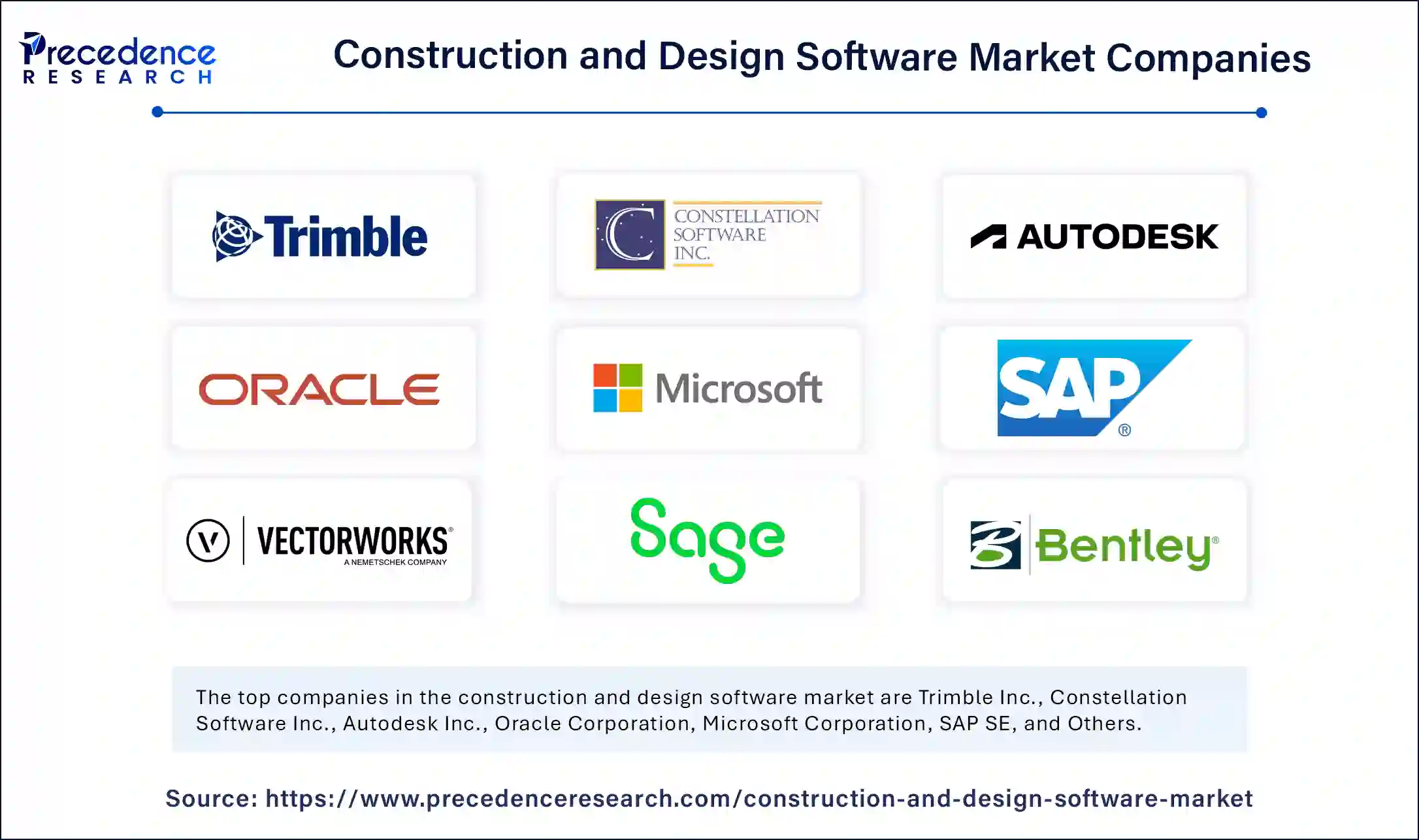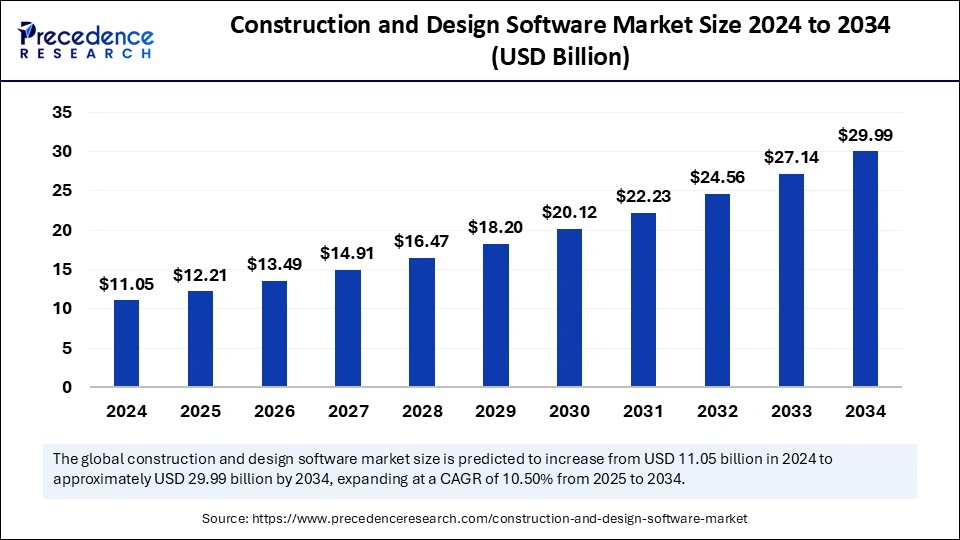The global construction and design software market size was valued at USD 11.05 billion in 2024 and is expected to reach around USD 29.99 billion by 2034, growing at a CAGR of 10.50%.
Get a Free Sample Copy of the Report@ https://www.precedenceresearch.com/sample/5798
Construction and Design Software Market Key Points
-
North America dominated the global market with a 33% share in 2024.
-
Asia Pacific is expected to register the fastest CAGR of 11.5% during the forecast period.
-
Project management and scheduling led by function, holding 19% of the market in 2024.
-
Bid management is projected to experience significant growth in the coming years.
-
On-premise deployment held the top share of 55% in 2024.
-
Cloud deployment is set to expand steadily through the forecast period.
-
Architects and builders represented the leading end-use segment with a 40% share.
-
Designers are anticipated to witness strong growth in the upcoming years.
Role of Artificial Intelligence (AI) in the Construction and Design Software Market
Artificial Intelligence (AI) is playing a transformative role in the construction and design software market, introducing smarter, faster, and more efficient solutions across all stages of project development.
One of the most valuable contributions of AI is in predictive analytics. By analyzing historical data, AI can forecast potential risks, cost overruns, and project delays, enabling construction managers and designers to make informed decisions early in the planning process. This not only improves budgeting accuracy but also enhances timeline management and reduces unexpected challenges.
AI is also revolutionizing design workflows through generative design. This technology allows professionals to input specific goals, such as spatial requirements, materials, and budget constraints, and automatically generate multiple optimized design options. This speeds up the creative process, promotes innovation, and often leads to more efficient use of space and materials.
In terms of project execution, AI supports real-time monitoring by integrating with sensors, drones, and IoT devices. This ensures continuous oversight of construction progress, helps maintain safety standards, and allows for real-time adjustments that keep projects on track.
Construction and Design Software Market Growth Factors
1. Rapid Urbanization and Infrastructure Development
The increasing need for residential, commercial, and industrial infrastructure—especially in emerging economies—is propelling demand for advanced design and construction tools that can streamline planning and execution.
2. Rising Adoption of Building Information Modeling (BIM)
BIM is becoming a standard in the construction industry due to its ability to improve collaboration, reduce errors, and increase efficiency. Governments in many regions are mandating its use for public infrastructure projects, further boosting market growth.
3. Digital Transformation Across the AEC Industry
Construction firms are increasingly investing in digital solutions to improve productivity, accuracy, and cost-efficiency. The shift from manual processes to software-based systems is creating a favorable environment for market expansion.
4. Integration of Emerging Technologies
Technologies such as artificial intelligence, machine learning, virtual/augmented reality, and IoT are being integrated into design and construction platforms. These enhance decision-making, project visualization, predictive analytics, and real-time monitoring.
5. Growing Demand for Cloud-Based Solutions
Cloud-based construction and design software is gaining popularity due to its scalability, flexibility, and accessibility. It supports real-time collaboration among stakeholders across different locations and simplifies software updates and maintenance.
6. Increased Focus on Sustainability and Green Construction
There’s a growing emphasis on designing energy-efficient and environmentally friendly buildings. Software tools help architects and engineers analyze energy performance, simulate sustainable designs, and meet regulatory compliance.
7. Improved Project Management and Cost Control
The need to manage complex construction projects, reduce delays, and control costs is driving the use of software solutions for scheduling, budgeting, and resource planning. These tools enhance transparency and efficiency throughout the project lifecycle.
Market Scope
| Report Coverage | Details |
| Market Size by 2034 | USD 29.99 Billion |
| Market Size in 2025 | USD 12.21 Billion |
| Market Size in 2024 | USD 11.05 Billion |
| Market Growth Rate from 2025 to 2034 | CAGR of 10.50% |
| Dominated Region | North America |
| Fastest Growing Market | Asia Pacific |
| Base Year | 2024 |
| Forecast Period | 2025 to 2034 |
| Segments Covered | Function, Deployment, End Use, and Regions |
| Regions Covered | North America, Europe, Asia-Pacific, Latin America, and Middle East & Africa |
Market Dynamics
Drivers
Key growth drivers include the adoption of Building Information Modeling (BIM), growing demand for cost and time-efficient construction processes, and the rise in smart city projects. The need to streamline workflows and reduce human error is also pushing the industry toward digital transformation.
Opportunities
The expansion of cloud-based platforms and AI integration in design tools presents a major opportunity. These innovations allow teams to work remotely, improve design accuracy, and speed up decision-making. The rising demand for sustainable buildings and smart infrastructure further opens avenues for advanced software applications.
Challenges
Challenges include high implementation costs, a shortage of skilled professionals, and resistance to change from traditional construction practices. Integration with legacy systems and data privacy concerns also slow down adoption in some regions.
Regional Insights
North America leads the global market due to early technology adoption and the presence of major software providers. Asia Pacific is expected to grow the fastest, fueled by rapid urbanization, government-led infrastructure initiatives, and increasing tech investment. Europe is focusing on sustainable construction practices, boosting software use across the region.
Recent Developments
- In July 2024, TestFit, a Dallas-based real estate development feasibility platform, announced the launch of a new tool called Generative Design. This tool enables architects and developers to optimize building and site layout designs effortlessly.
- In February 2025, Hover, a leader in 3D property data, released Instant Design, an AI-powered design product. This product enables construction pros and homeowners to instantly visualize any home remodeling or new construction project.
- In March 2025, Trimble unveiled the 2025 versions of Tekla Structural Designer, its structural analysis and 3D design software for multimaterial buildings, and Tekla Tedds, its automated civil and structural analysis calculation software. With several significant updates, both products offer enhanced user experience and expanded design capabilities for an optimized design collaboration experience.
- In September 2024, Zenerate launched an AI-powered design automation tool, Zenerate App, to quickly generate and identify optimal design schemes, and eliminate the need to redraw floor plans to fit a unit mix. Zenerate App generates building and site plan options in real time to meet specific project objectives.
Construction and Design Software Market Companies

- Trimble Inc.
- Constellation Software Inc.
- Autodesk Inc.
- Oracle Corporation
- Microsoft Corporation
- SAP SE
- Vectorworks, Inc.
- Sage Group plc
- BENTLEY SYSTEMS
- RIB Software SE
Segments Covered in the Report
By Function
- Safety & Reporting
- Project Management & Scheduling
- Project Design
- Field Service Management
- Cost Accounting
- Construction Estimation
- On across Bid Management
- Others
By Deployment
- On-premise
- Cloud
By End-use
- Architects & Builders
- Remodelers
- Designers
- Others
By Region
- North America
- Europe
- Asia Pacific
- Latin America
- Middle East and Africa (MEA)
Also Read: Circular Economy Consulting Services Market
Ready for more? Dive into the full experience on our website@ https://www.precedenceresearch.com/

